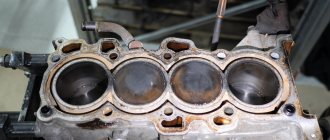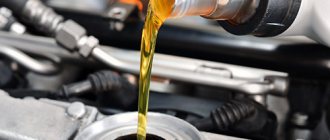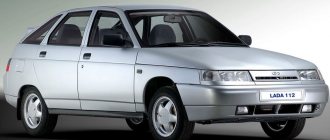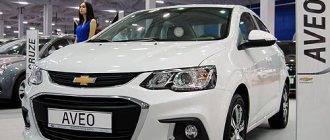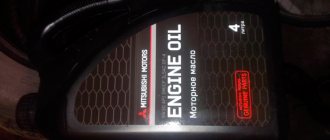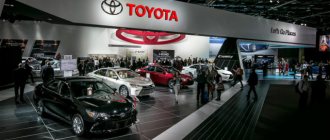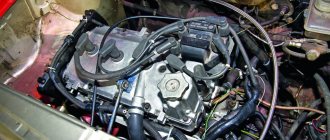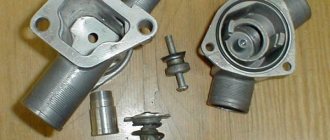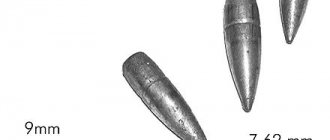A very pressing issue, around which there is a lot of controversy and conversation. Some argue that there is nothing better than the proven classic in the form of an atmospheric internal combustion engine. Others are sure that aspirated engines are already a thing of the past, and the present and future belong to turbocharged engines. When choosing between an atmospheric engine and a turbocharged one, you need to rely not on the opinions of other car enthusiasts, but on your own preferences, needs and capabilities. The engines are truly different in design, characteristics and capabilities. But this does not make one of them clearly the best and the other the worst. It is necessary to analyze the features of the motors, which will allow us to draw the appropriate conclusions.
Engine choice: turbocharged or naturally aspirated.
Which engine is better, naturally aspirated or turbocharged?
Before buying a car, many drivers ask the question: “Which engine is better: naturally aspirated or turbocharged?” Let's look at the differences between them and compare the positive and negative characteristics.
A car engine is a mechanism that converts energy of some kind into mechanical energy necessary to propel the vehicle. The operation of any internal combustion engine is based on the principle of combustion of the air-fuel mixture in a closed chamber. The more air gets into the cylinders, the more fuel is consumed, and as a result, the amount of energy generated will increase. It follows that power and torque directly depend on the engine size.
Pros and cons of naturally aspirated engines
With the advent of power units equipped with a turbocharger, many drivers began to prefer turbocharged vehicles. However, there are many motorists who, when asked which engine is better, naturally aspirated or turbocharged, choose the usual classic option, based on the following advantages:
- Long service life.
- Simplicity of the device.
- No serious problems during operation.
- Availability of DIY repairs and maintenance.
- Reduced engine oil consumption.
Atmospheric internal combustion engines have the longest mileage. There are known cases when cars with installed aspirated engines operate without major repairs along the way, more than 500 thousand kilometers. The only condition is timely care and regular replacement of engine oil and filters. Their parts and components are wear-resistant. The reliable naturally aspirated engine has an increased service life and continues to work even after repeated replacements of the car body.
Thanks to the trouble-free operation of the naturally aspirated engine and the ease of its operation, it is unpretentious to the quality of fuel and lubricants. With regular use of gasoline of reduced quality, such engines, even if they fail, quickly restore their performance. The main requirement for motor oil is to ensure the required level. The lubricant should be replaced every 15 - 20,000 km. When choosing the most suitable brand of motor oil for a naturally aspirated engine, it is recommended to give preference to synthetic or semi-synthetic.
Interesting: Unlike a turbocharged engine, you can also use mineral oils here if you were unable to purchase better lubricants.
The simplicity of the aspirated design allows some repair work to be carried out even in a garage. When contacting a car service center, the cost of services is several times lower compared to repairing similar faults in turbocharged engines.
Atmospheric internal combustion engines have some disadvantages:
- Relatively heavy weight of the mechanism.
- Reduced power and developed torque compared to a motor equipped with a turbine.
- Aspirated engines are not designed to operate under heavy loads.
- Difficulties in operating at high altitudes in thin air conditions.
- When a naturally aspirated engine operates at low speeds, a sufficient amount of air is not always sucked in, which affects the stability of operation.
Atmospheric power unit
An atmospheric engine (AM) is a type of engine that was first created during engine construction. It got its name from the very atmosphere that surrounds us and participates in the process of burning the combustible mixture in the engine. IM is the simplest engine without the use of additional equipment to increase its power.
An atmospheric engine does not have an air injection system into the intake system and operates at a pressure equal to atmospheric pressure, sucking in air flows naturally. In other words, through the filtration system, the pistons, like a pump, draw in air, and with the help of an injector or carburetor, these air masses are mixed with fuel, forming a combustible mixture that soon ignites. Once ignited, the mixture creates energy that drives the working parts of the motor. This operating principle has its advantages and disadvantages.
Advantages of an atmospheric engine:
- Increased engine life. Practice shows that the service life of this type of engine can be hundreds of thousands of kilometers before the first major overhaul. This is due to relatively small loads. Of course, such production is possible only subject to timely and high-quality maintenance of the unit.
- Simplicity of design - as a result, reliability and ease of operation and maintenance.
- High maintainability. If one or another part of the engine fails, its repair will be relatively inexpensive, which is undoubtedly a huge plus.
- Less engine oil consumption due to the absence of additional parts that require lubrication.
- No increased requirements for oil quality. It is possible to use mineral, semi-synthetic and synthetic types of oil, but saving on quality can significantly reduce the “lifetime” of the engine.
- Fuel quality. An atmospheric engine can process even the lowest grade fuel, but it is highly recommended not to “poison” it, in order to avoid an early breakdown.
- Longer mileage between oil changes. It changes every 15-20 thousand kilometers and this must be carefully monitored, otherwise the consequences for the engine will be disastrous.
- Faster warm-up, unlike a turbocharged one.
The naturally aspirated engine is perfect for measured and calm driving on city streets.
As for the disadvantages, we can note:
- Less engine power compared to a turbocharged one, with the same volume.
- Large dimensions and weight of the unit.
- Greater fuel consumption than a turbocharged engine.
- Difficulties when traveling in mountainous areas due to thin air and low pressure.
- Less environmentally friendly to use.
Atmospheric engines are in great demand among car owners due to the previously listed advantages.
For good purging (i.e., filling with the working mixture and removal of exhaust gases), four valves per cylinder are installed on modern IMs. Two for air intake and two for exhaust. This ensures maximum efficiency and power of the motor.
Aspirated or turbocharged engine
And so, naturally aspirated or turbocharged engine. If we take their differences initially, then the engines are not structurally different. The only difference is that increased air flow is added to the intake system and the fuel supply changes accordingly in the direction of increasing it.
You can install a supercharging system on a naturally aspirated engine, that is, a turbine that increases the incoming air flow into the intake system, we adjust the fuel supply, and here you have a turbocharged engine.
Let's take a deeper look at what atmospheric and turbocharged are.
Atmospheric engine
What does atmospheric mean? As mentioned above, a naturally aspirated engine does not have an air injection system into the intake system.
We recommend: Design and principle of operation of a manual transmission
Air is sucked in naturally; the intake pistons suck in air, creating negative pressure during the intake phase. In this cycle, fuel is sucked in along with air, forming the fuel mixture necessary for one or another operating mode of the engine.
//auto-ru.ru/wp-content/uploads/2017/11/atmosferni-dvigatel.mp4
For good purging, as they call good filling of the working mixture and removal of exhaust gases, four valves per cylinder are installed on modern atmospheric engines. Two for intake and two for exhaust.
In this case, maximum engine efficiency is ensured relative to its cylinder volume and, accordingly, maximum power.
Advantages of an atmospheric engine:
- increased resource;
- simplicity of design;
- consumption of low-octane fuels;
- less oil consumption;
- longer mileage before oil change;
- engine warms up faster.
Disadvantages of a naturally aspirated engine:
- less power;
- fuel consumption is high;
- less environmentally friendly.
Turbocharged engine
As mentioned above, this is an atmospheric engine with a turbine installed on it. This is how you can imagine a turbocharged engine. But installing a turbine simply won’t do.
The turbine operates from the movement of exhaust gases, spinning the shaft with the impeller to crazy speeds. At the other end of the turbine shaft there is an impeller, the so-called compressor, which supplies air under pressure to the intake manifold.
The compressor pumps air, much more of it enters the cylinders than in an atmospheric engine. Due to this, it becomes possible to create several times more ready-made combustible mixture in one intake stroke. In a turbocharged engine, of course, during the combustion of this mixture, more energy is released, the result is a sharp increase in power.
The crankshaft, camshafts, connecting rods, pistons, valves in a turbocharged engine remain the same as on a naturally aspirated engine.
In order for a turbocharged engine to operate stably and for a long time, many modifications and improvements related to turbine lubrication and cooling of the supplied air are required.
Turbocharged engines are faster, more powerful, and operate at higher temperatures.
In addition to the turbine, the turbocharged engine is complemented by an additional radiator (intercooler), which serves to cool the air entering the intake system.
The intercooler is necessary to ensure that the mixture does not enter the cylinders too hot, in order to save it from detonation and overheating.
Pros of a turbocharged engine:
- increased power;
- reduced size and weight;
- reduced total fuel consumption.
Disadvantages of a turbocharged engine:
- reduced resource;
- requires high-quality oil;
- requires high-quality fuel;
- increased oil consumption;
- poor warm-up;
- need to change oil more often.
We recommend: How to connect a car radio to 220 correctly
Turbocharged engine
The first turbocharged engine (TE) was invented in 1905, and began to be used in passenger cars in the mid-20th century. It differs from the atmospheric one by the presence of an additionally installed turbine. The function of the turbine is to pump air masses into the working cylinders of the engine.
Air intake does not occur naturally, but is stimulated with the help of additional equipment, due to which the air flows are more voluminous, and more combustible mixture is formed during one intake stroke. A turbocharger, consisting of a turbine and a fan, is connected to the exhaust system, providing exhaust gases to the turbine blades. Using a compressor, gases under high pressure are pumped into the combustion chamber. Engine power increases significantly due to increased pressure and complete combustion of the air-fuel mixture. A turbocharged engine is capable of producing more horsepower than a naturally-aspirated engine with the same displacement.
Turbocharged engines are more revving and can operate at high temperatures. To ensure long-term operation of the TD, it is necessary to pay great attention to its improvements in the field of lubrication of parts and cooling of the supplied air. In addition to the turbine, an additional device is installed on a turbocharged engine - an intercooler, which solves the problem of overheating. The intercooler operates by using circulating air instead of coolant.
IMPORTANT : the intercooler on the TD is necessary to prevent detonation in the event of engine overheating due to the entry of an overheated mixture into the cylinders.
The advantages of a turbocharged power unit are:
- Power. Higher than atmospheric due to air forced under pressure. With the same volumes, a turbocharged engine can produce power and torque 70% higher than a naturally-aspirated one. Actually, increasing power is the main point of modifying the engine design.
- Small size and weight. Compact in size and easy to use. Suitable for almost any car, and due to its simple design, it can be installed using existing fasteners.
- Lower fuel consumption (relative to horsepower).
These are the three main points that motorists pay attention to first. In addition, the advantage of a turbocharged engine is its high environmental friendliness (due to more efficient combustion of fuel in the cylinders and lower content of harmful substances in the exhaust gases). TD makes less noise than AD.
Engine disadvantages:
- Increased requirements for fuel quality. Unlike a naturally aspirated engine, a turbocharged one is quite capricious and breaks down quickly if you use cheap, low-quality fuel.
- Increased fuel consumption. It is caused by a large volume of incoming air, requiring a larger volume of combustible mixture. It is impossible to artificially reduce fuel consumption, because when spinning up, the engine independently pumps in the required level of fuel.
- Increased requirements for the quality of motor oil. Mineral and semi-synthetic oils are not used; special oil is required for TD. Often, the brand of oil recommended by the manufacturer is unreasonably overpriced. In this case, the service life of the oil filter is shorter, because A turbocharged engine has to operate at fairly high temperatures.
- Increased engine oil consumption. This is due to the fact that, unlike an atmospheric engine, with a turbocharged engine, the oil is changed every 10,000 km.
- The turbine resource is quite short, only about 120,000 km, after which it needs to be replaced, even if the unit has been maintained at a high level. This is due to the rapid wear of the turbine.
- Expensive repairs are a big minus that plays an important role. Frequent replacement of consumables and turbines will significantly hit your pocket.
- Long warm-up and idle for about 2 minutes at the end of the trip (a turbocharged engine needs to cool down gradually to last longer).
–>Auto parts and service stations –>
Before buying a car, each of us faces a lot of dilemmas; we need to choose between manufacturers, brands and models of cars, different trim levels, and most importantly, between power units. The common question: “Which is better, diesel or gasoline?” can only compete in popularity with the question: “ Which is better to choose, a turbine or an aspirated engine ?”
Today, in our section on constant dilemmas, we will raise the pressing question of which engine is better to buy - naturally aspirated or turbocharged, and we will talk about the advantages and disadvantages of each of them to make your choice simpler and more correct.
First of all, it is necessary to understand one important point, the fact is that it is impossible to say unequivocally that a turbine or an aspirated engine is better, both have their “pros” and “cons”. So, let's take it in order.
Advantages and disadvantages of naturally aspirated engine
First of all, for those who are not in the know, I will tell you what an aspirated vehicle is . An atmospheric engine is usually called a conventional internal combustion engine (ICE), which uses air from a carburetor or injector to form a fuel-air mixture (1 part gasoline to 14 parts air). With the advent of turbo engines, the choice of car became more complicated, as drivers began to be increasingly tempted by more powerful turbocharged units, giving them preference over conventional internal combustion engines. However, there are also those who still hesitate to buy a turbine due to lack of knowledge or experience in operating this engine.
Features of atmospheric internal combustion engines
Everyone has heard about naturally aspirated engines, but not everyone understands exactly what this means. In the classical sense, this is a gasoline internal combustion engine, the design of which involves pumping air from the environment. For this purpose, special carburetor pistons are used. When oxygen penetrating inside the engine mixes with fuel particles sprayed by the injectors, a so-called fuel mixture is formed. It is needed for combustion inside the combustion chamber. Atmospheric engines work as follows:
- the process of air absorption occurs from the atmosphere;
- fuel and oxygen are mixed in the required proportions (usually 1 to 14);
- a mixture of fuel and oxygen enters the combustion chamber;
- the volume expands;
- pressure appears on the piston;
- rotation is transmitted to the crankshaft;
- car rides.
Moreover, in the case of naturally aspirated engines, the process of suction or air intake occurs due to the fact that a rarefied atmosphere is created in the intake manifold. When choosing an aspirated or turbocharged engine, it will not be superfluous to know about the principles of their operation and design features. This will allow you to understand in advance what possible problems you will encounter, as well as how difficult the repair will be in a given situation.
The undoubted advantages of atmospheric engines include:
- Simplicity of design, which has been proven in practice for many decades. Repair and maintenance of such power units cost the owner much less (compared to similar operations for a turbocharged engine).
- Significantly longer service life of uninterrupted operation before major repairs. Under the right operating conditions and proper care, the lifespan of naturally aspirated engines is 2–4 times longer than that of turbocharged engines: 300,000–400,000 km is often not the limit of the “longevity” of such engines.
- Lower oil consumption, which, depending on driving style, usually does not exceed 200÷500 ml per 10,000 km of vehicle mileage. This is due to the absence of additional devices that require lubrication, as well as lower loads experienced by the rotating parts of the motor during operation.
- Unpretentiousness to the quality of the oil used. They work quite satisfactorily on semi-synthetic (and even mineral) motor oils. However, do not forget that the better the oil, the longer the engine life.
- The frequency of oil changes is not as frequent as with turbocharged engines, which must be done after a mileage of 15,000÷20,000 km.
- Less demanding on the quality of the fuel used. As a rule, many naturally aspirated engines can operate quite satisfactorily on AI92 gasoline.
- Faster warm-up in winter.
How to turbocharge a naturally aspirated engine
And finally, let's look at how to turbocharge a naturally aspirated engine.
If previously no one took on such work, today some qualified car services are able to turn an ordinary engine into a real “beast”.
The only thing you need to remember is that this work will result in serious costs for the owner to purchase additional materials and install them.
In particular, it is necessary to additionally mount an intercooler, a turbine, an additional interceptor unit, and so on. But that's not all.
To get a turbocharged engine, significant optimization must be made to the fuel system - you will have to install a more powerful fuel pump, strengthen the piston group, spend money on injectors with higher throughput, and so on.
Thus, the result is a kind of engine tuning, and in the case of reworking the latter, it is necessary to recalculate the costs several times to ensure the relevance of such an event.
Advantages and disadvantages of a turbocharged engine
the turbocharged engine in 905, and turbines began to be installed on passenger cars only in the middle of the 20th century. The principle of an engine equipped with a turbine is that the turbine rationally uses the vehicle exhaust, through which additional air is pumped into the cylinders, which promotes better combustion of the fuel-air mixture. As you know, the more air, the better it will burn, a turbo engine is designed on the same principle, a turbine pumps air into the cylinders under high pressure, due to which the combustion of the fuel mixture occurs with greater efficiency, as a result the engine receives at least 10% more power. .
Turbocharged engine: advantages
The advantages of turbocharged engines (compared to naturally aspirated analogues) include:
- Higher power (usually 30÷50%) with the same working volume.
- Maximum torque over a wide speed range, which has a very positive effect on the dynamics of the car.
- Less weight and size with the same power. A turbocharged engine is much lighter and more compact than a naturally aspirated one. This allows for the most rational placement of the power unit and reduces the total weight of the vehicle, which, in turn, contributes to fuel economy.
- Fast set of operating speeds due to the lower mass of rotating parts.
- High environmental friendliness, which is achieved due to more complete combustion of fuel in the engine cylinders.
Disadvantages of a naturally aspirated engine
The most important disadvantage of such an engine can be considered the lack of high torques.
The naturally aspirated unit is inferior to the turbocharged unit in terms of power. Such a car would be ideal for leisurely trips around the city, but it is clearly not suitable as a track car for youth racing. Fuel consumption for such an engine will be quite high. As experts from Favorit Motors Group note, on average, a car with a naturally aspirated engine consumes at least 11-12 liters of fuel per 100 kilometers.
Turbocharged engine: disadvantages
Among the disadvantages of turbocharged engines there are more operational disadvantages. Firstly, an engine with a turbine is more picky about the quality of fuel and engine oil. In addition, on such engines the service life of lubricating and filter elements is much shorter than that of naturally aspirated engines, approximately 1.5-2 times, this is explained by more difficult operating conditions at high temperatures. Owners of turbocharged engines should more carefully monitor the level and condition of filters and oil, and replace them in strict accordance with the engine manufacturer's instructions. The condition of the air filter is equally important; a clogged or damaged filter impairs the performance of the compressor and can cause it to malfunction.
The disadvantages of a turbo engine also include its “gluttony”. A turbine, compared to an aspirated engine of the same volume, will “eat” more fuel.
In addition, a turbo engine has a shorter engine life than a naturally aspirated engine . The turbine wears out over time, especially if the owner does not have the skills to operate such engines. For example, after stopping the car, a turbo engine must be allowed to idle for a while so that the turbine cools down and only then can the engine be turned off.
Advantages and disadvantages of a modern turbo engine
Before we begin to analyze the pros and cons of a turbo engine, I would like to once again draw your attention to one nuance. According to marketers, the share of new turbocharged cars sold today has increased significantly
Moreover, numerous sources emphasize that turbo engines are increasingly being replaced by “aspirated” ones; car enthusiasts often choose “turbo” because they consider naturally aspirated engines to be a hopelessly outdated type of internal combustion engine, etc. Let's figure out whether a turbo engine is really that good.
Pros of a turbo engine
- Let's start with the obvious advantages. Indeed, a turbo engine is lighter in weight, smaller in displacement, but still produces high maximum power. Also, turbine engines provide high torque, which is available at low speeds and is stable over a wide range. In other words, turbo engines have a flat torque level, available from the very bottom to relatively high speeds.
- In a naturally aspirated engine there is no such level shelf, since thrust directly depends on engine speed. At low speeds, an atmospheric engine usually produces less torque, that is, it needs to be spun up to obtain acceptable dynamics. At high speeds, the engine reaches maximum power, but torque decreases as a result of natural losses that occur.
- Now a few words about the efficiency of turbo engines.
Such engines actually consume less fuel compared to atmospheric units under certain conditions. The fact is that the process of filling the cylinders with air and fuel is completely controlled electronically. It turns out that the ECU ensures that the ratio of the mixture components is optimal in any operating modes of the turbocharged internal combustion engine, due to which complete combustion of the charge is achieved and maximum useful energy is released. In the case of naturally aspirated engines, filling depends both on the crankshaft speed and on the outside air temperature, atmospheric pressure and a number of other factors. - If we take into account the light weight of the unit itself with the turbine, the available thrust at low speeds and the lack of dependence on external factors, the turbo engine naturally consumes less fuel in normal operating modes. It should be remembered that this advantage completely disappears if you constantly drive in the “gas to the floor” mode. Then the fuel consumption of a turbo engine may be even greater than that of atmospheric analogues.
Disadvantages of a turbocharged internal combustion engine
So, we’ve sorted out the main advantages. As for the disadvantages, they are also present. It is quite obvious that a turbo engine is more complex both in terms of electronics and actuators, and in terms of the implementation of the turbocharging circuit itself. Increased requirements for the quality of fuel and engine oil have also not gone away.
The fact is that the unit, small in size and volume, operates under conditions of high mechanical and thermal loads. Boost pressure and cylinder temperatures are much higher compared to naturally aspirated engines, which means accelerated wear on the turbo engine.
Manufacturers take into account various nuances, putting a greater margin of safety into the unit, but during repair of a turbo engine, the cost of reinforced parts is significantly higher. Also, an engine with a turbine has a large number of sensors and lines, as well as additional systems, which complicates diagnostics in case of malfunctions.
- A very important point is the resource of the turbine itself. The turbocharger is universally installed on modern internal combustion engines, finally displacing the mechanical compressor. At the same time, a turbine on a gasoline engine usually runs only about 150 thousand km; on a diesel engine, this figure averages up to 250 thousand km. The turbocharger then needs expensive repairs or complete replacement.
- As for the well-known problem in the form of “turbo lag” or “turbo lag”, on modern engines this drawback is practically eliminated by installing variable geometry turbines, by using “bi-turbo” technologies, etc. Why practically, and not completely? The fact is that there is still no ideal sharpness of response during dosing of thrust during the throttling process, which is characteristic of naturally aspirated engines. In parallel, more complex turbocharging systems require increased costs and create certain difficulties associated with maintenance and repair.
How's the fuel consumption?
If you carefully read about the pros and cons of both engines (aspirated and turbocharged), then you were surprised that we didn’t say anything about fuel consumption. It is worth dwelling on this issue in a little more detail. Let's try to figure out which motor is more economical.
First, let's compare two engines with the same volume (for example, 1.4 liters). An atmospheric engine will consume on average about 6÷7 liters per 100 km, while a trumpet engine will require 8÷9 liters. However, at the same time, it develops a power 1.5 times greater than atmospheric. Conclusion: with the same displacement, the naturally aspirated engine is much more economical (after all, it not only “eats” less fuel, but also uses cheaper gasoline), but is significantly inferior to the turbocharged engine in terms of power.
Now let’s compare the fuel consumption of engines with the same power (for example, about 140÷150 hp). So many “horses” under the hood usually have a 2.0-liter naturally-aspirated engine or a 1.4-liter turbocharged engine. In the urban cycle, the consumption of a conventional engine will be about 12÷14 liters per 100 km, while that of a turbocharged engine will be the same 8÷9 liters. Conclusion: even taking into account the lower cost of gasoline required for normal operation of an atmospheric engine, a turbocharged engine is much more economical.
As you can see, both engines have their pros and cons; in order to understand which engine is better - turbocharged or naturally aspirated , you need to understand for yourself the priority aspects of a particular unit.
Which engine is better to choose a car with?
Both types of motors have both their advantages and disadvantages. Therefore, it is impossible to say for sure which one is better. If you are a fan of aggressive driving, quick starts from a standstill, love drive and are ready for significant maintenance costs, then the choice is clear - a car with a turbocharged engine. However, when leaning towards such a choice, you must remember that the engine of your vehicle (and especially the turbine) will “live” much less than its atmospheric counterpart. In addition, you must be sure that in your region you can easily purchase high-quality fuel, as well as special synthetic oils.
If your driving style is characterized by calm, forethought and caution, and you are also a practical and frugal person, then the excess power of a turbocharged engine is simply not gentle for you. But the reliability, ease of maintenance and durability of an atmospheric engine will significantly save the cost of its daily operation.
Sources: avto-moto-shtuchki.ru, vopros-avto.ru, etc.
Don't forget!
Everything is being repaired, the only question remains in choosing a service station. This choice is only yours!
What is a turbocharged engine in a car?
The first turbocharged engines were designed back in 1905, but they began to be installed in passenger cars in the second half of the 20th century. Turbocharging is a system of forcing additional air into the cylinders of an atmospheric engine, resulting in an increase in the average effective pressure in the cylinders. This increases the power of the motor without making changes to its design. The operation of a turbocharged engine is ensured by a drive supercharger that uses the energy of exhaust gases. They drive the turbine wheel, which in turn rotates the compressor wheel using a rotor shaft. The compressor wheel compresses the air, which is heated, and after entering the intercooler, it is cooled and supplied to the cylinders.
It is important! The energy of the exhaust gases increases as the engine rotation speed increases. The more intense the motor works, the greater the energy potential becomes and the supply of compressed air increases.
Until recently, turbocharged engines were installed exclusively on expensive sports car models. But, according to marketers, currently the share of models with such engines is rapidly increasing, and the turbine is becoming almost a mandatory element of prestigious car brands.
Turbines are installed much more often on diesel engines than on gasoline ones.
Car manufacturers emphasize that turbo engines are mercilessly crowding out naturally aspirated engines, and most buyers of good cars prefer this type of engine. But is a turbo engine as good as the designers and engineers of automobile companies describe it? To draw conclusions, it is worth considering its design features and taking a closer look at the principle of operation.
Design features
The turbocharging system consists of a compressor, intercooler, boost pressure regulator and other components. The main part is the turbocharger, which regulates the increase in pressure in the air intake system. The intercooler cools the air and increases its density.
Air movement pattern during operation of a turbocharged engine
The entire system is controlled by a boost regulator. This is a bypass valve that limits the exhaust gas pressure. By cutting off a certain amount of them, the valve makes the boost pressure optimal.
The turbocharger works as follows:
- The air passes through the air filter and enters the inlet.
- The air is compressed and its oxygen content increases. The air heats up and its density decreases.
- The air masses leave the turbocharger and enter the intercooler, where cooling occurs.
- Compressed air penetrates through the throttle and intake manifold into the engine cylinders.
- Part of the exhaust gases generated during the combustion of fuel in the cylinders is transferred by the turbo engine back to the turbine manifold. This air flow starts the movement of the shaft, at the opposite end of which the compressor is located. This is where the recompression of the air begins.
It is important! The result of turbocharging is an increase in the level of oxygen compression while maintaining the volume of the cylinders. In one cycle of operation, a turbo engine burns more fuel mixture than an atmospheric engine of the same volume.
Advantages and disadvantages
Turbocharged engines have their strengths and weaknesses, so you shouldn’t believe automakers’ statements about their clear advantage. Before deciding to choose a car equipped with a turbocharged gasoline engine, you should weigh the pros and cons.
Advantages
The main advantage of a turbocharged engine is its increased power, and one cannot but agree with the manufacturers on this. In terms of power, with a similar cylinder volume, the unit exceeds atmospheric engines by 20–30%. Additional advantages of installing a turbocharger on a motor are as follows:
- Increasing operating efficiency by optimizing the combustion process of the airless mixture in the cylinders. Thanks to this, fuel consumption to ensure the operation of a similar amount of naturally aspirated engine horsepower is significantly reduced.
- Reduced noise and vibration levels while driving.
- Environmentally friendly. Efficient combustion of fuel inside the cylinders significantly reduces the amount of emissions into the atmosphere through the exhaust pipe. Experts say that the introduction of new emission standards in Europe and the United States has increased the production of cars with turbocharged gasoline engines by 25%.
- Compact sizes. An engine with three or even two cylinders is comparable in power to a four-cylinder naturally aspirated one. Thanks to its optimal dimensions, such an engine has a greater number of placement options in the car.
Examples of vehicles with powerful naturally aspirated engines
The modern car market features naturally aspirated cars produced under well-known brands:
- Mercedes C 63 FMG Coupe Edition 507.
- Chevrolet Corvette C 7 Stingray.
- Jeep Grand Cherokee SRT.
- Audi RS 5.
- Audi RS 4 Avant.
- Chevrolet Camaro.
- Mercedes SLK 55 AMG.
- Porsche Cayenne GTS.
- Infiniti QX 70.
- Lexus LS 460.
- Mercedes-Benz OM 602.
- OM 612.
- OM 647.
- BMW M57.
Which engine is better: naturally aspirated or turbocharged?
The long debate between fans of naturally aspirated and turbocharged engines is far from its logical conclusion. Each option has its own advantages and disadvantages. The constant developments of engineers and designers, adding advantages to one or another option, do not allow one to tip the balance.
Most car owners agree that a naturally aspirated engine, although inferior in power to a turbocharged one, is still more reliable in operation. It is unpretentious in choosing the brand of gasoline and oil, and can be repaired in any auto repair shop. For turbocharged engines, such “liberties” are not allowed.
A turbocharged engine is an expensive pleasure: it requires more attention, careful maintenance, and proper operation. The turbine itself, even if all operating recommendations are followed, has a limited service life and requires replacement after a fairly short period of time.
Therefore, you need to choose a motor option according to your own financial capabilities. The atmospheric option is preferable for car owners who are on a limited budget and are not ready to invest significant funds in the car. Maintenance, operation and repair of the naturally aspirated engine are clearly simpler and cheaper.
A turbocharged engine is the right choice for those who prioritize engine power and driving dynamics. Although such a motor can cause a lot of problems and expenses during operation.
An important factor in choosing a motor is the driving style of the car owner. For a driver who prefers quiet driving, a turbocharged engine is a useless feature. In this case, the cost of a high-power motor is not justified, because the turbine will not perform its functions. But even without using the power plant for its intended purpose, it will have to be maintained according to the rules, which means simply throwing money away.
When buying a car with a turbine, experts advise choosing new models. Only in this case can you be sure that the unit was properly maintained and operated. A car with a turbine “killed” by the previous owner will cause many times more problems than the pleasure of driving it.
Video: turbo and naturally aspirated engines: what is the difference?
In modern conditions, the increase in the number of cars with turbocharged engines concerns, first of all, diesel units. Currently, almost all diesel engines are equipped with a turbocharger, since it is this part that gives a diesel engine decent performance characteristics.
With turbo-gasoline engines the situation is different. Most automakers continue to produce models with simple atmospheric engines, and only some lines add turbo gasoline engines. The fewest such models are on the roads in the CIS countries. This is explained by the lack of demand and the policy of car dealers, who try to protect themselves from problems that arise during the operation of cars and fulfillment of warranty obligations. Sellers take into account the low quality of gasoline and the lack of a sufficient number of highly qualified car mechanics in the CIS.
The answer to the question of whether it is worth buying a gasoline car equipped with a turbine depends on the plans of the car enthusiast. If you plan to drive the car for 3–5 years and cover 150–200 thousand kilometers, with enough available funds, why not. But for those buyers who are not ready to overpay for power and spend money on expensive car maintenance, it is better to opt for a traditional naturally aspirated engine.
You should definitely refuse to buy a used car with a turbocharger, keeping in mind the limited resource of the turbine. Such models are often purchased by young people and “racers” who “roll” a powerful car and practically do not care for it according to the rules. After using the unit to its full potential, it is easier for them to sell it than to invest in repairs. A second-hand car with a turbocharged gasoline engine will absolutely cause a lot of trouble for the new owner.
